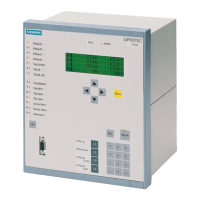Mounting and Commissioning
3.3 Commissioning
SIPROTEC, 7UM62, Manual
C53000-G1176-C149-7, Release date 03.2010
421
3.3.13 Checking the Differential Protection
Preparation
Before commencing any primary tests, make sure that the configured object is actually the one you want to
protect, and that the amplitude matching for the current ratings of the protected object and the main primary
CTs, and the vector group matching are correctly set.
Switch differential protection (address 2001) to Block relay or interrupt the tripping commands.
The test arrangement varies with the application.
On network power transformers
and asynchronous machines, a low-voltage test is preferably conducted,
where low-voltage current source is used to energize the protected object, which is completely disconnected
from the network (Figure 3-25). A short-circuit bridge, which is capable of carrying the test current, is installed
outside the protected zone and allows the symmetrical test current to flow.
For power station unit transformers
and synchronous machines, the tests are performed during the current
tests, with the generator itself supplying the test current (Figure 3-26). The current is produced by a short-circuit
bridge which is installed outside the protected zone and is capable of carrying generator rated current for a
short time. In such a case after the machine is started but not yet excited, a check is made using remanence
currents that no current transformer circuit is open or short-circuited. In order to achieve this, read out the op-
erational measured values and check all operational currents one by one. Even if the currents and the mea-
surement accuracy are very small, such errors can actually be detected.
The current for commissioning tests must be at least 2 % of the rated device current.
Figure 3-25 Current check with low-voltage current source
Figure 3-26 Current test in the power station

